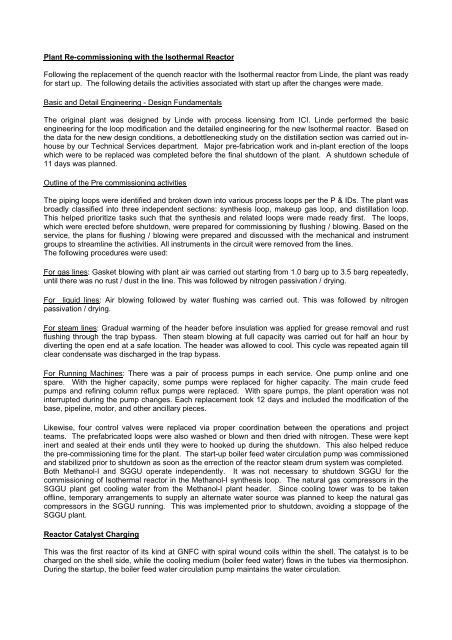Methanol Plant Capacity Enhancement By: Mr. C D ... - Fibre2fashion
Methanol Plant Capacity Enhancement By: Mr. C D ... - Fibre2fashion
Methanol Plant Capacity Enhancement By: Mr. C D ... - Fibre2fashion
Create successful ePaper yourself
Turn your PDF publications into a flip-book with our unique Google optimized e-Paper software.
<strong>Plant</strong> Re-commissioning with the Isothermal Reactor<br />
Following the replacement of the quench reactor with the Isothermal reactor from Linde, the plant was ready<br />
for start up. The following details the activities associated with start up after the changes were made.<br />
Basic and Detail Engineering - Design Fundamentals<br />
The original plant was designed by Linde with process licensing from ICI. Linde performed the basic<br />
engineering for the loop modification and the detailed engineering for the new Isothermal reactor. Based on<br />
the data for the new design conditions, a debottlenecking study on the distillation section was carried out inhouse<br />
by our Technical Services department. Major pre-fabrication work and in-plant erection of the loops<br />
which were to be replaced was completed before the final shutdown of the plant. A shutdown schedule of<br />
11 days was planned.<br />
Outline of the Pre commissioning activities<br />
The piping loops were identified and broken down into various process loops per the P & IDs. The plant was<br />
broadly classified into three independent sections: synthesis loop, makeup gas loop, and distillation loop.<br />
This helped prioritize tasks such that the synthesis and related loops were made ready first. The loops,<br />
which were erected before shutdown, were prepared for commissioning by flushing / blowing. Based on the<br />
service, the plans for flushing / blowing were prepared and discussed with the mechanical and instrument<br />
groups to streamline the activities. All instruments in the circuit were removed from the lines.<br />
The following procedures were used:<br />
For gas lines: Gasket blowing with plant air was carried out starting from 1.0 barg up to 3.5 barg repeatedly,<br />
until there was no rust / dust in the line. This was followed by nitrogen passivation / drying.<br />
For liquid lines: Air blowing followed by water flushing was carried out. This was followed by nitrogen<br />
passivation / drying.<br />
For steam lines: Gradual warming of the header before insulation was applied for grease removal and rust<br />
flushing through the trap bypass. Then steam blowing at full capacity was carried out for half an hour by<br />
diverting the open end at a safe location. The header was allowed to cool. This cycle was repeated again till<br />
clear condensate was discharged in the trap bypass.<br />
For Running Machines: There was a pair of process pumps in each service. One pump online and one<br />
spare. With the higher capacity, some pumps were replaced for higher capacity. The main crude feed<br />
pumps and refining column reflux pumps were replaced. With spare pumps, the plant operation was not<br />
interrupted during the pump changes. Each replacement took 12 days and included the modification of the<br />
base, pipeline, motor, and other ancillary pieces.<br />
Likewise, four control valves were replaced via proper coordination between the operations and project<br />
teams. The prefabricated loops were also washed or blown and then dried with nitrogen. These were kept<br />
inert and sealed at their ends until they were to hooked up during the shutdown. This also helped reduce<br />
the pre-commissioning time for the plant. The start-up boiler feed water circulation pump was commissioned<br />
and stabilized prior to shutdown as soon as the errection of the reactor steam drum system was completed.<br />
Both <strong>Methanol</strong>-I and SGGU operate independently. It was not necessary to shutdown SGGU for the<br />
commissioning of Isothermal reactor in the <strong>Methanol</strong>-I synthesis loop. The natural gas compressors in the<br />
SGGU plant get cooling water from the <strong>Methanol</strong>-I plant header. Since cooling tower was to be taken<br />
offline, temporary arrangements to supply an alternate water source was planned to keep the natural gas<br />
compressors in the SGGU running. This was implemented prior to shutdown, avoiding a stoppage of the<br />
SGGU plant.<br />
Reactor Catalyst Charging<br />
This was the first reactor of its kind at GNFC with spiral wound coils within the shell. The catalyst is to be<br />
charged on the shell side, while the cooling medium (boiler feed water) flows in the tubes via thermosiphon.<br />
During the startup, the boiler feed water circulation pump maintains the water circulation.

















